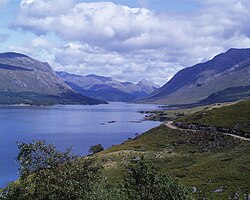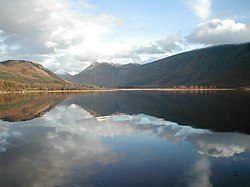Loch Etive


Loch Etive is a long sea loch cutting deep into Argyllshire. It reaches the sea at Connel, 3 miles north of Oban. It measures 19¾ miles) long and from three quarters of a mile to 1.0 mile wide. Its depths vary greatly and reach a maximum of about 600 feet (100 fathoms).
The name Etive is from Gaelic, in which the loch is known as Loch Eite. It is believed to mean little ugly one from the ancient Gaelic Goddess associated with the loch. It heads east for half its length alongside the main A85 road and railway to Oban, before heading northeast between mountainous terrain. A road along Glen Etive makes the head of the loch accessible from Glencoe.
The narrow mouth of the loch results in its most unusual feature, the Falls of Lora.
Part of the north bank has been designated a Special Area of Conservation in particular due to old sessile oak woods. A small colony of around 20 common seals is resident in Loch Etive.
Just seaward of the mouth of the loch is Dunstaffnage Castle. This was a stronghold of the kingdom of Dalriada until the 9th century, and possibly its centre at one time. It is believed to have held the Stone of Scone before its transfer to Scone Palace. The current ruins date from 1275. Cruises up Loch Etive followed by carriage trip to Glen Coe were started in 1881 as Oban developed as a fashionable resort.
Connel Bridge, an impressive cantilever bridge at the Falls of Lora, has an interesting history. Built in 1903 for the Connel-Ballachulish railway, a rail-bus ferried foot-passengers across from 1909 until 1914 when the bridge was converted to allow for rail, road or passenger traffic (on the same track). Since the line closed in 1966, the bridge has been solely for road traffic.
In the parish of Ardchattan, on the north shore, stands the beautiful ruin of St. Modan's Priory, founded in the 13th century for Cistercian monks of the Valliscaulian Order. It is said that Robert Bruce held within its walls the last parliament in which the Gaelic language was used. On the coast of Loch Nell, or Ardmucknish Bay, is the vitrified fort of Beregonium.
Miscellany
Loch Etive was the name of an Iron Clipper Ship aboard which Joseph Conrad served.
Outside links
Coordinates: 56°29′N 5°09′W / 56.483°N 5.15°W